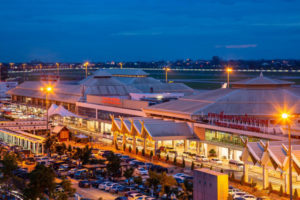
Chiang Mai airport extending its operating hours around the clock starting in November key to tourism revival
Tourism sector hopes to unlock potential of region as aviation hub extends hours
With Chiang Mai airport extending its operating hours around the clock starting in November, the tourism sector hopes to unlock the potential of the northern region to welcome more foreign tourists arriving via direct flights.
Sittipong Wongsomboon, general manager of Northern Smile Travel, said the average occupancy rate for hotels in September dropped to 30-35% from 70-80% in August, as this is a slow period for tourism.
The Chiang Mai market shifted to independent travellers after the pandemic, with some hotels adjusting to secure better room rates, even with fewer tourists, said Mr Sittipong.
As a founder of the “Hotels in Chiang Mai” group, he said around 35 boutique hotels in central Chiang Mai and other related businesses banded together as a group to add value to their services instead of offering cheap prices.
The potential markets are mostly travellers from Asia, particularly from countries that have direct flights to Chiang Mai airport. They can also help generate revenue for other provinces in the region, said Mr Sittipong.
By tapping these travellers, hotels in the group set their room rates at around 3,000 baht per night, rising to 5,000-10,000 baht during the high season, compared with the market average of 800-900 baht in the province.
“Travellers from Hong Kong, Taiwan and Singapore led the market in terms of hotel spending. Some Chinese independent tourists were unfazed by slow economic growth in their country,” he said. “The situation has changed from before the pandemic, when we had a lot of tourists, but hotels competed for guests by cutting their prices.”
From Nov 1, Chiang Mai airport is slated to operate 24 hours a day, catering to international flights after midnight and early flights before 6am.
Santisuk Klongchaiya, chief executive of Thai AirAsia, said the airline is preparing to add more international flights to Chiang Mai this year. Thai AirAsia offers eight routes now connecting the province with Hong Kong, Macau, Da Nang, Hanoi, Taipei and Singapore, as well as China’s Hangzhou and Beijing Daxing airports.
He said Chiang Mai has high potential to be an aviation hub connecting Northeast Asia as it enables single-aisle aircraft with shorter flight times to reach more cities in China, Japan and South Korea.
Chiang Mai is the second hub of Thai AirAsia, in addition to Don Mueang airport, as it has five aircraft stationed at this airport.
With Thailand recently removing visa requirements for Chinese, there is room for local carriers to increase flights from Chinese cities to Chiang Mai. Of the total number of seats for China routes, Thai carriers account for 40% and Chinese airlines 60% as they have more advantages in terms of networks in China, said Mr Santisuk.
Source: https://www.bangkokpost.com/business/general/2655085



